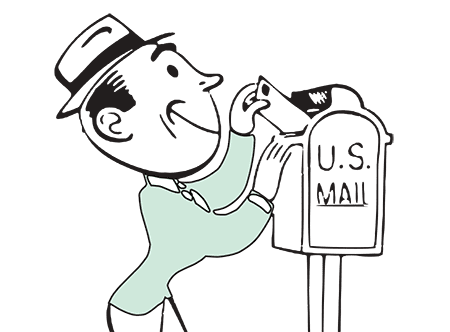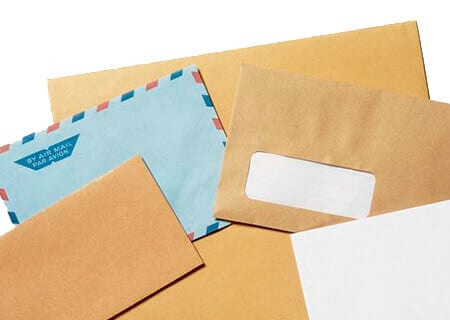If you run a business, church, or non-profit in the 21st century, you’re not at a loss for marketing options. Where you might be at a loss is figuring out how to sort through all the options to make your best moves. The high-touch “touchable” stuff, like direct mail, phone calls, and hand-written notes, haven’t gone away, all the while new, faster, digital options—like email and social media—are cropping up in more and more sophisticated ways.
Direct Mail vs. Email: When to Send Which
Sorting through your options may not be simple. So when do you use email for your campaign, and when do you stick with direct mail?
Why direct mail?
Though the volume of letter-writing and direct mail has decreased significantly in the past twenty-five years or so, it’s still not close to doomed. (We’re waiting for the slap bracelet to make a comeback, though.)
People connect to paper. Materials which engage more of the senses stick in the memory longer, evoke emotion better, and persuade with aspects like presence and texture that email will never have. Response rates for direct mail remain high. When done well, a good old paper-and-envelope investment continues to be worth it, even with all those emails, texts, and tweets at people’s fingertips.
Mail and email: a love story
No matter which you choose for your next campaign, mail and email work best when there’s a natural flow between them. Because when folks find a message important or moving, they often instinctively transfer it to another format to keep or share it.
For example, you might receive a particularly touching email and print it out to save it in a shoebox of memories (digital → physical). Or your little nephew might write something funny in a birthday card, so you snap a photo of it with your phone and post it on Facebook (physical → digital).
You know that fancy new word, “omni-channel?” Bingo.
For example, in email, you can do this with names, direct phone numbers, links to chat, printable coupons or tickets, or an option to sign up for direct mail. With direct mail, you can do the same with hashtags, web addresses, email addresses, or any snap-able, shareable content. Make sure readers can always find you, on and off the grid.
When to choose email
So how do you pick the front-runner for your next campaign? Matching your message and timing to your format is one of the key aspects of getting attentive readers.
Email typically works best in the following scenarios:
Regular, short communications
Got a blog to share? A devotional reflection? A weekly newsletter? How about reminders for events, rehearsals, classes, or schedules? Weekly offers? If the frequency and the brevity are both high enough, consider a texting service to supplement email.
Saying hello
Follow up on a conversation or visit, respond to social media interest, or piggyback on prospects’ engagement with your website. It’s crucial to do this right away, opening the marketing funnel. Subject lines and first lines should refer specifically to the previous interaction (even use the person’s name), for example, “Saying thanks for your visit” or “Did we answer your question, Peter?”
Major news or announcements
Announce anything majorly important—a retirement, a resignation, a relocation, a campaign update, big event details, etc.—with email. Direct mail explaining why the CEO has stepped down or the Christmas pageant times have changed may not get to your readers quickly enough (or at all) and cause confusion.
Media and sharing
Until we all live in the Wizarding World of Harry Potter, we’re not going to get videos, Twitter feeds, or photo albums fitting into a #9 business envelope. When you have media to share, want people to spread the news, or need to broaden your audience’s options for engagement, email’s probably the right vehicle.
Direct mail vs. email
Direct mail’s main benefit is physical presence. It tends to work best for invitations, major news, and long-form, personal, extremely formal, or high-touch communications. Email’s main benefits are speed, cost, and flexibility. It tends to work best for quick, frequent, repeated, urgent, or shareable communications.
When to choose direct mail
We don’t think there’s ever a bad day for a letter. But here are some clues to when it’s an especially good day:
Being “pinnable,” literally
One huge advantage of direct mail is its physical presence in a home, office, or car. It’s its own reminder to re-read and re-engage. Sometimes you literally want people to pin your materials to a fridge or corkboard, for example. Calendars are perfect for this, as are invitations to special events and fundraisers, lists of customer benefits or discounts, membership cards, and coupons.
Urgency and weight
Bills, invoices, and documents of legal import make an impression in the form of direct mail. But if you want to add urgency or weight to any communication, paper can help communicate this. For centuries, paper has been the chosen medium for the most important information.
Major news or announcements
Remember how we said this should be for email? Well, there’s a big exception. Special, infrequent publications sent well ahead of time for planning purposes, such as yearly calendars and brochures that explain new initiatives, are perfect for direct mail. So are specialized “big news” announcements to VIPs and high-touch groups.
Building loyalty
Loyalty is built by being there for your people when they need you. But it’s also built by drawing them more deeply into your story, your vision, and your daily doings. Yearly appreciation letters, “insider” updates, special check-ins, and longer publications like booklets go here. Invitations also fall under this category. This is where you can get fancy and cushy with your material details, tell your long story, and really invest in drawing readers into a deeper sense of being on the “ins.”
We hope this helps clear things up! Just like mail and email are not a zero-sum game, neither is direct mail and envelope. Give them equal love, and boost your open rates, responses, and ROI. Letter Jacket Envelopes can help. Get in touch today, and we’ll give you free shipping on your first order.



